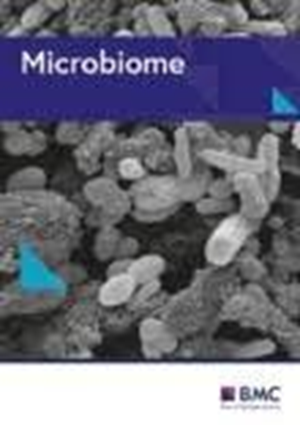Predicting how varying moisture conditions impact the microbiome of dust collected from the International Space Station
IF 13.8
1区 生物学
Q1 MICROBIOLOGY
引用次数: 0
Abstract
The commercialization of space travel will soon lead to many more people living and working in unique built environments similar to the International Space Station, which is a specialized closed environment that contains its own indoor microbiome. Unintended microbial growth can occur in these environments as in buildings on Earth from elevated moisture, such as from a temporary ventilation system failure. This growth can drive negative health outcomes and degrade building materials. We need a predictive approach for modeling microbial growth in these critical indoor spaces. Here, we demonstrate that even short exposures to varying elevated relative humidity can facilitate rapid microbial growth and microbial community composition changes in dust from spacecraft. We modeled fungal growth in dust from the International Space Station using the time-of-wetness framework with activation and deactivation limited growth occurring at 85% and 100% relative humidity, respectively. Fungal concentrations ranged from an average of 4.4 × 106 spore equivalents per milligram of dust in original dust with no exposure to relative humidity to up to 2.1 × 1010 when exposed to 100% relative humidity for 2 weeks. As relative humidity and time-elevated increased, fungal diversity was significantly reduced for both alpha (Q < 0.05) and beta (R2 = 0.307, P = 0.001) diversity metrics. Bacteria were unable to be modeled using the time-of-wetness framework. However, bacterial communities did change based on constant relative humidity incubations for both beta (R2 = 0.22, P = 0.001) and alpha diversity decreasing with increasing moisture starting at 85% relative humidity (Q < 0.05). Our results demonstrate that moisture conditions can be used to develop and predict changes in fungal growth and composition onboard human-occupied spacecraft. This predictive model can be expanded upon to include other spacecraft environmental factors such as microgravity, elevated carbon dioxide conditions, and radiation exposure. Understanding microbial growth in spacecraft can help better protect astronaut health, fortify spacecraft integrity, and promote planetary protection as human activity increases in low-Earth orbit, the moon, Mars, and beyond.预测不同湿度条件如何影响从国际空间站收集的尘埃的微生物群落
太空旅行的商业化将很快导致更多的人在类似国际空间站的独特建筑环境中生活和工作,国际空间站是一个专门的封闭环境,包含自己的室内微生物群。与地球上的建筑物一样,在这些环境中,由于湿度升高(如通风系统临时故障),可能会出现意外的微生物生长。这种生长会对健康造成负面影响,并使建筑材料降解。我们需要一种预测方法来模拟这些关键室内空间中的微生物生长。在这里,我们证明了即使短时间暴露在不同的相对湿度升高的环境中,也能促进航天器尘埃中微生物的快速生长和微生物群落组成的变化。我们利用湿润时间框架对国际空间站尘埃中的真菌生长进行了建模,在相对湿度分别为 85% 和 100% 的情况下,真菌的生长受到激活和失活的限制。真菌浓度范围从原始尘埃中每毫克尘埃平均 4.4 × 106 个孢子当量(未暴露于相对湿度)到暴露于 100%相对湿度下 2 周后高达 2.1 × 1010 个孢子当量(未暴露于相对湿度)。随着相对湿度和时间的增加,真菌多样性的α(Q < 0.05)和β(R2 = 0.307,P = 0.001)多样性指标都显著降低。细菌无法使用湿润时间框架建模。不过,细菌群落确实在恒定相对湿度培养的基础上发生了变化,β(R2 = 0.22,P = 0.001)和α多样性从相对湿度 85% 开始随着湿度的增加而减少(Q < 0.05)。我们的研究结果表明,湿度条件可用于开发和预测载人航天器上真菌生长和组成的变化。这一预测模型还可扩展到其他航天器环境因素,如微重力、二氧化碳升高条件和辐射暴露。随着人类在低地球轨道、月球、火星及更远的地方活动的增加,了解航天器中微生物的生长有助于更好地保护宇航员的健康、加强航天器的完整性和促进行星保护。
本文章由计算机程序翻译,如有差异,请以英文原文为准。
求助全文
约1分钟内获得全文
求助全文
来源期刊

Microbiome
MICROBIOLOGY-
CiteScore
21.90
自引率
2.60%
发文量
198
审稿时长
4 weeks
期刊介绍:
Microbiome is a journal that focuses on studies of microbiomes in humans, animals, plants, and the environment. It covers both natural and manipulated microbiomes, such as those in agriculture. The journal is interested in research that uses meta-omics approaches or novel bioinformatics tools and emphasizes the community/host interaction and structure-function relationship within the microbiome. Studies that go beyond descriptive omics surveys and include experimental or theoretical approaches will be considered for publication. The journal also encourages research that establishes cause and effect relationships and supports proposed microbiome functions. However, studies of individual microbial isolates/species without exploring their impact on the host or the complex microbiome structures and functions will not be considered for publication. Microbiome is indexed in BIOSIS, Current Contents, DOAJ, Embase, MEDLINE, PubMed, PubMed Central, and Science Citations Index Expanded.
 求助内容:
求助内容: 应助结果提醒方式:
应助结果提醒方式:


